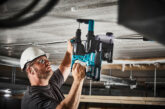
The experts at Electrium take a closer look at Arc Fault Detection Devices and why they could offer essential protection against fires caused by electrical equipment.
Chapter 42
Regulation group 421 in Chapter 42 of the IET Wiring Regulations specifically relates to protection against fire caused by electrical equipment.
Unfortunately electrical equipment can be a source for ignition and cause fires. In the year ending June 2021 there were about 29,800 accidental dwelling fires attended by fire services in Great Britain, approximately 24,300 of these were in England, 4,100 in Scotland and 1,400 in Wales.
Government statistics include the fires where the cause of ignition is recorded as being electrical distribution and electrical appliances and leads. Typically electrical fires make up almost a quarter of all fires (source: Gov Data Tables 0602).
Caught on Camera
PE readers will be familiar with the magazine’s Caught on Camera page that often shows charred or burnt electrical equipment and cables that have been found and removed before a fire can start.
If every installation was regularly inspected and free from misuse, DIY impacts, poor quality workmanship, loose connections, rodent attacks, or aging cable insulation, then maybe the number of electrical fires would be reduced.
That’s an unlikely scenario, however, so we therefore must consider how the electrical installation industry can play its part in reducing the number of electrical fires. Fortunately some help is at hand in the form of a clever device called an AFDD. By the time you read this (with the publishing of Amendment 2) you might be looking at more reasons to install them, especially in higher risk premises.
Protecting people and property
Chapter 42 states that people, livestock and property shall be protected against harmful effects of heat or fire which may be generated or propagated in electrical installations, and that the harmful effects of heat or fire may be caused by: failure of electrical equipment insulation faults or arcs, sparks and high temperature particles. Insulation faults are just one example of a fault condition that can lead to arcing and fire.
AFDDs can detect a serial or parallel arc in 230V final circuits and disconnect the power supply before ignition of cable insulation and nearby flammable materials.
Whether AFDDs are mandated by the regulations, or by the client, or recommended by contractors as suitable for a particular installation or application, installers will want AFDDs that are as easy to install as MCBs or RCBOs.
Meeting the need
Electrium AFDDs meet this need. They are all single module devices, around the same size as an MCB, designed to fit into regular consumer units. Taking up only one way each, they don’t require any special assembly processes or special enclosures.
AFDDs from Electrium include an integral Type A 30mA RCBO. This makes life easy for installers because this single device provides the earth leakage protection, overload protection and short circuit protection that is required, as well as arc fault protection. Plus it’s a two pole switching device that totally isolates any faulty circuit/equipment.
Installation and testing?
Single module miniature AFDDs from Electrium are compatible with final ring circuits (including spurs and appliance leads) and radial circuits. They will detect serial and parallel arc faults wherever they can occur in such circuits.
Installing and testing Electrium AFDDs is simple, the installation process is already familiar to installers because it’s the same process that installers have been using for RCBOs for decades. The device clips onto the DIN rail, it’s then connected to the busbar, the neutral lead is connected to the neutral bar, and the circuit cables are connected to the device. It’s as simple as that.
Testing of the device is also easy. When the device is first powered up it runs an automatic self-test function and will repeat the self-test function every 15 hours. The RCBO element is tested in the same was as any RCD RCBO, by pressing the test button, or with an RCD tester.
There’s an added benefit too from the two pole switching mechanism; there’s no need to disconnect the circuit cables to carry out Insulation & Resistance testing during EICRs. Simply switch the device off and carry out your tests.
Automatic fault diagnosis
Electrium AFDDs automatically indicate the type of fault that has caused a device to trip. The device will indicate if there’s an earth leakage fault, it will indicate if there is an arc fault, and it will tell you if there’s been an overvoltage, all of which will make fault finding quicker and easier.
Not so awkward after all!
Early adopters of this technology from Crabtree & Wylex will tell you that the Electrium devices do not need bigger enclosures, or special busbars, or special working processes. That’s because they are designed to be suitable for new and retrofit installations, and to help future-proof performance specifications.
Upgrades are simple – in many cases installers can take out an MCB or RCBO and replace it with an AFDD, providing protection for people and property by using standard Electrium products.
To watch Electrium’s AFDD Q&A video, click here










